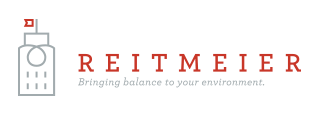What if we told you that taking a holistic approach to managing your building can help you keep tenants happy, while paring down costs and inefficiencies?
If you’re familiar with Reitmeier, you’re probably not surprised. Even though we’re a commercial HVAC service provider, our entire team has a notable obsession with healthy buildings.
Why? Because at Reitmeier, we know that buildings are more than the sum of their parts. Our HVAC work affects (and is affected by) every other system that contributes to the environment in your building.
And what could be more important than creating a healthy, productive environment for your tenants? Fewer complaints and maintenance calls are an indicator not only of tenant happiness, but that all of your building systems are performing optimally and efficiently.
But how do you get there? Keep reading to learn our 4 key strategies for creating healthy buildings and happy tenants.

4 Steps for Bringing Balance to Your Buildings
You may have noticed that we bring up the concept of “balance” quite often. Beyond being the mission that drives everything we do at Reitmeier, a balanced environment is one of the most accurate expressions of the health of your building and its systems.
Think of your building like a doctor would their patient. How would you approach improving his/her health? Your process would probably include a full diagnostic, any necessary treatment plans, a check-up schedule, and an agreement to stick to the plan.
You may be surprised to learn that the steps to improving the health of your building are quite similar:
1. Consider all of your building’s systems and their needs.
Because you’re not a building doctor (yet), this first step is to understand the physics of your building’s ecosystem.
Your building is more than the sum of its parts – think of it like a living organism made up by a network of systems, all of which must work together to create a healthy environment for your tenants. This makes it incredibly ineffective to diagnose and treat your building systems in isolation, and requires a comprehensive approach to thinking about the health of your building.
2. Conduct a full systems analysis to understand the best move for your building.
Armed with a full understanding of your building’s systems, you can make smarter decisions about where to invest your time, energy, and money.
For example, if you reach out to an HVAC provider for help regulating your building’s temperature, that provider should investigate related, non-HVAC building systems to uncover the root of the problem. You don’t want to replace your entire HVAC system when a more effective solution may be simpler (supplemental insulation or draft prevention, for example).
The truth is there are layers of cost to be considered before moving forward with a treatment plan for your building: upfront costs (purchase and installation), costs accrued over time (energy costs, repair and maintenance), and sunk costs (the cost of lost productivity and sick time related to unhealthy working environments). Accounting for all of these costs as they relate to your building’s systems is the most efficient, effective way to create a healthy environment and happy tenants.
3. Commit to a preventative maintenance plan.
Each and every one of your building’s systems need attention – and on more than an ad hoc basis. A preventative maintenance plan is essential for the health of your building and the happiness of your tenants.
Contractors and maintenance providers should look to follow a suggested maintenance schedule for each of your building’s systems, and should be diligent about documenting work, updating maintenance schedules, checking off inspections, and maintenance completion.

When you are proactive with a preventative maintenance plan instead of being reactive, you have more control over your time, you avoid spending money on costly emergencies or equipment repairs, and you keep your tenants smiling and paying rent.
4. Stay diligent and realize the results
of a healthy relationship.
The final directive is all about follow through. But what results can you expect to see from a diligently followed maintenance plan, or a decision-making framework informed by holistic analysis?
- Optimized building system operations
- Fewer emergency repairs and replacements
- Reduced costs associated with building maintenance
- Happy tenants that stick around and pay rent
This is arguably the most important of the four steps, as a healthy relationship is a happy relationship.
To schedule a free no-obligation assessment of your HVAC equipment and current maintenance condition, request a quote or click here to read about what we do.

